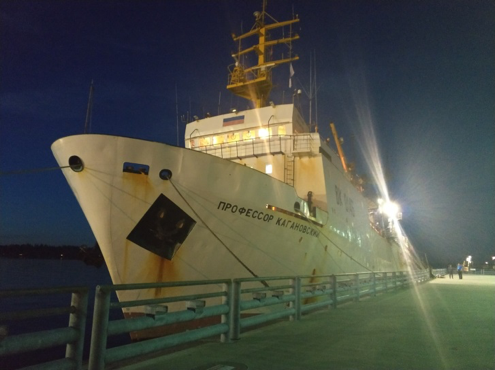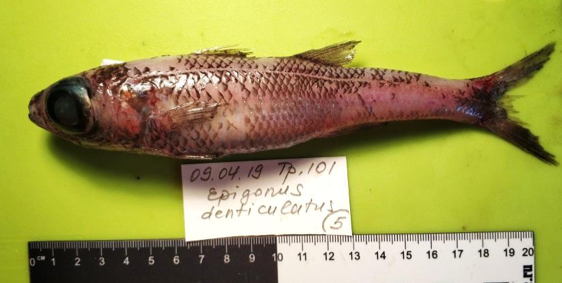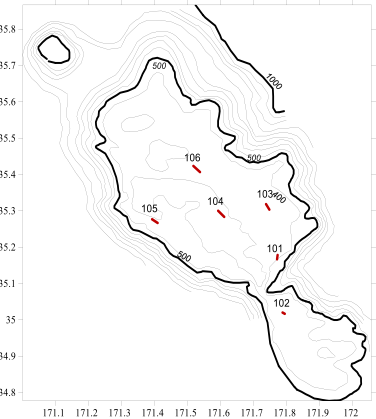[from Deep-Sea Life Vol 13]
Somov, A.A., Kanzeparova, A.N., Orlova, S.Yu., Kurnosov, D.S., Zuev, M.A., Orlov, A.M
Russian fisheries research on the Emperor Seamounts began in the 1960s. Despite long-term observations, the ichthyofauna of this area has not been fully studied, even at the level of species composition. Ecosystems of seamounts in general, and those of Emperor Seamounts (Fig. 1) in particular, are highly productive. However, being localized and isolated, these ecosystems are very vulnerable, especially commercially important species such as pelagic armorhead (Pseudopentaceros wheeleri) and alfonsinos (Beryx splendens and B. decadactilus). Heavy commercial exploitation of their resources in the 1970s and 1980s caused significant restructuring of fish communities.

In April 2019, research on board Russian research vessel Professor Kaganovsky (Pacific Branch of the Russian Federal Research Institute of Fisheries and Oceanography – TINRO, Vladivostok, Fig. 2) on Koko, Lira, Ojin and Jingu seamounts (Fig. 3) were conducted. Trawlings were carried out using bottom trawl at depths ranging from 291 to 1030 m. Thirty six species of demersal and benthopelagic fishes, including meso – and epipelagic fish (Fig. 4), and another six species of cephalopods were registered in the catches, of which 11 species were not observed in a previous Russian survey in this area in 2010. Among benthopelagic species at least six (Congriscus megastomus, Meadia abyssalis, Nettastoma parviceps, Embassichthys bathybius, Icelus sp., Elassodiscus sp.) were not observed in this area earlier (Borets, 1980; Novikov et al., 1981). It can be concluded that the real species richness of benthic and pelagic ichthyofauna of the Emperor Seamounts are much higher as compared with those from published literature and known from previous cruise reports.

Fig. 3. Positions of trawlings (in red) made on Koko (left), Lira (center), and Ojin and Jingu (right) seamounts; numbers are isobaths (italic) and haul numbers (regular).
Fig. 4. Example of mesopelagic fishes.
In addition, the distributional shift of some fish species from the southern seamounts to the northern ones should also be noted. The pencil cardinal (Epigonus denticulatus) became the most abundant species (Fig. 5) on Koko seamount (central part of the area) recently. In the 1970-80s, this species was observed on Milwaukee seamounts (southernmost part of the area) and on Hawaian Ridge and was not found on Koko seamount (Borets, 1986). As surveys in 2010 and 2019 showed, the range of pencil cardinal has been extended northward considerably. In addition to this species, catches of the Japanese codling Physiculus japonicus and Paraulopus oblongus composed significant portions of the catches while in the past they occurred in this area in insignificant amounts. In the 1960s and 1970s, pelagic armorhead (Fig. 6) was the dominant species in catches, accounting for up to 93.3% of catches, while since the 2010s it it accounts for 2‒7%. The opposite pattern is observed in pencil cardinal. Previously, the catches accounted for less than 1% while in the 2010s it increased to 69-81% (Fig. 7).












